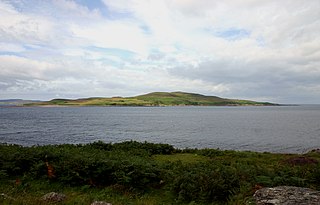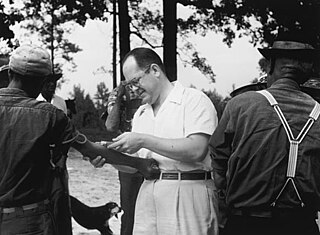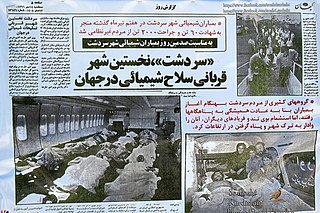Related Research Articles

A gas mask is an item of personal protective equipment used to protect the wearer from inhaling airborne pollutants and toxic gases. The mask forms a sealed cover over the nose and mouth, but may also cover the eyes and other vulnerable soft tissues of the face. Most gas masks are also respirators, though the word gas mask is often used to refer to military equipment, the scope used in this article. The gas mask only protects the user from digesting, inhaling, and contact through the eyes. Most combined gas mask filters will last around 8 hours in a biological or chemical situation. Filters against specific chemical agents can last up to 20 hours.
Nerve agents, sometimes also called nerve gases, are a class of organic chemicals that disrupt the mechanisms by which nerves transfer messages to organs. The disruption is caused by the blocking of acetylcholinesterase (AChE), an enzyme that catalyzes the breakdown of acetylcholine, a neurotransmitter. Nerve agents are irreversible acetylcholinesterase inhibitors used as poison.

Gruinard Island is a small, oval-shaped Scottish island approximately 2 kilometres long by 1 km wide, located in Gruinard Bay, about halfway between Gairloch and Ullapool. At its closest point to the mainland, it is about 1 km offshore. In 1942, the island became a sacrifice zone, and was dangerous for all mammals after military experiments with the anthrax bacterium, until it was decontaminated in 1990.

Mustard gas or sulfur mustard is any of the several chemical compounds that contain the chemical structure S(CH2CH2Cl)2. In the wider sense, compounds with the substituent S(CH2CH2X)2 and N(CH2CH2X)3 are known as sulfur mustards and nitrogen mustards, respectively, where X = Cl or Br. Such compounds are potent alkylating agents, which can interfere with several biological processes. Also known as mustard agents, this family of compounds are infamous cytotoxins and blister agents with a long history of use as chemical weapons. The name mustard gas is technically incorrect: the substances, when dispersed, are often not gases but a fine mist of liquid droplets. Sulfur mustards are viscous liquids at room temperature and have an odor resembling mustard plants, garlic, or horseradish, hence the name. When pure, they are colorless, but when used in impure forms, such as in warfare, they are usually yellow-brown. Mustard gases form blisters on exposed skin and in the lungs, often resulting in prolonged illness ending in death. The typical mustard gas is the organosulfur compound bis(2-chloroethyl) sulfide.

Porton Down is a science and defence technology campus in Wiltshire, England, just north-east of the village of Porton, near Salisbury. It is home to two British government facilities: a site of the Ministry of Defence's Defence Science and Technology Laboratory – known for over 100 years as one of the UK's most secretive and controversial military research facilities, occupying 7,000 acres (2,800 ha) – and a site of the UK Health Security Agency. Since 2018, part of the campus has housed Porton Science Park, which is owned and operated by Wiltshire Council and has private sector companies in the health, life science and defence and security sectors.
Operation Antler was a 1999 police investigation into experiments conducted on humans at the British government's Porton Down research establishment between 1939 and 1989. Several cases were sent to the Crown Prosecution Service but none proceeded to criminal prosecutions.

The United Kingdom possesses, or has possessed, a variety of weapons of mass destruction, including nuclear, biological, and chemical weapons. The United Kingdom is one of the five official nuclear weapon states under the Treaty on the Non-Proliferation of Nuclear Weapons. The UK renounced the use of chemical and biological weapons in 1956 and subsequently destroyed its general stocks.
Leading Aircraftman Ronald George Maddison was a twenty-year-old Royal Air Force mechanic who was unlawfully killed as the result of exposure to nerve agents while acting as a voluntary test subject at Porton Down, in Wiltshire, England. After substantial controversy, his death was the subject of an inquest 51 years after the event.

From 1948 to 1975, the U.S. Army Chemical Corps conducted classified human subject research at the Edgewood Arsenal facility in Maryland. The purpose was to evaluate the impact of low-dose chemical warfare agents on military personnel and to test protective clothing, pharmaceuticals, and vaccines. A small portion of these studies were directed at psychochemical warfare and grouped under the prosaic title of the "Medical Research Volunteer Program" (1956–1975). The MRVP was also driven by intelligence requirements and the need for new and more effective interrogation techniques.

Project 112 was a biological and chemical weapon experimentation project conducted by the United States Department of Defense from 1962 to 1973.

Nazi human experimentation was a series of medical experiments on prisoners by Nazi Germany in its concentration camps mainly between 1942 and 1945. There were 15,754 documented victims, of various nationalities and age groups, although the true number is believed to be more extensive. Many survived, with a quarter of documented victims being killed. Survivors generally experienced severe permanent injuries.
Operation Top Hat was a "local field exercise" conducted by the United States Army Chemical Corps in 1953. The exercise involved the use of Chemical Corps personnel to test biological and chemical warfare decontamination methods. These personnel were deliberately exposed to these contaminants, so as to test decontamination.

Holmesburg Prison, given the nickname "The Terrordome," was a prison operated by the city of Philadelphia, Pennsylvania and the Pennsylvania Department of Prisons (PDP) from 1896 to 1995. The facility is located at 8215 Torresdale Ave in the Holmesburg section of Philadelphia. It was decommissioned in 1995 when it closed. As of today, the structure still stands and is occasionally used for prisoner overflow and work programs.

Numerous experiments which are performed on human test subjects in the United States are considered unethical, because they are performed without the knowledge or informed consent of the test subjects. Such tests have been performed throughout American history, but some of them are ongoing. The experiments include the exposure of humans to many chemical and biological weapons, human radiation experiments, injections of toxic and radioactive chemicals, surgical experiments, interrogation and torture experiments, tests which involve mind-altering substances, and a wide variety of other experiments. Many of these tests are performed on children, the sick, and mentally disabled individuals, often under the guise of "medical treatment". In many of the studies, a large portion of the subjects were poor, racial minorities, or prisoners.
Chemical weapons were widely used by the United Kingdom in World War I. The use of poison gas was suggested by Winston Churchill and others in Mesopotamia during the interwar period, and also considered in World War II, although it appears that they were not actually used in these conflicts. While the UK was a signatory of the Hague Conventions of 1899 and 1907 which outlawed the use of poison gas shells, the conventions omitted mention of deployment from cylinders.

Keen as Mustard is a documentary film researched and directed by Bridget Goodwin detailing secret experiments conducted during World War II on Australian servicemen volunteers to investigate the effects of, and precautions against, mustard gas when used as a weapon in the tropics. The film, released by Film Australia in 1989, contains extensive historic documentary footage and accounts by several participants, and was made possible by the overseas acquisition of documents that remained restricted by the Australian government. A book of the same name was published in 1998, containing much additional material due to the release of some formerly restricted documents by the AWM in 1992.
Unethical human experimentation is human experimentation that violates the principles of medical ethics. Such practices have included denying patients the right to informed consent, using pseudoscientific frameworks such as race science, and torturing people under the guise of research. Around World War II, Imperial Japan and Nazi Germany carried out brutal experiments on prisoners and civilians through groups like Unit 731 or individuals like Josef Mengele; the Nuremberg Code was developed after the war in response to the Nazi experiments. Countries have carried out brutal experiments on marginalized populations. Examples include American abuses during Project MKUltra and the Tuskegee syphilis experiments, and the mistreatment of indigenous populations in Canada and Australia. The Declaration of Helsinki, developed by the World Medical Association (WMA), is widely regarded as the cornerstone document on human research ethics.

On 28 June 1987, Iraq dropped mustard gas bombs on Sardasht, West Azerbaijan, Iran. In two separate bombing runs on four residential areas, the attack killed 130 people and injured 8,000. The gas attacks occurred during the Iran–Iraq War when Iraq frequently used chemical weapons against Iranian civilians and soldiers.
Chemical weapons have been a part of warfare in most societies for centuries. However, their usage has been extremely controversial since the 20th century.

RAF Bowes Moor was a chemical warfare agent (CWA) storage site run by the Royal Air Force during and after the Second World War. The site was to the north of the village of Bowes in what is now County Durham, England. The Bowes Moor geographical feature runs from the north to the south west of the village. The Royal Air Force used the site to stock its chemical weapon supply, most of which was disposed of in situ by burning. The site, which closed in 1947, is known for the dangerous chemicals which leached into the soil.
References
- 1 2 Evans, Rob (1 September 2007). "Military scientists tested mustard gas on Indians". The Guardian. Retrieved 28 February 2019– via www.theguardian.com.
- ↑ "UK tested poison gas on Indian soldiers - USATODAY.com". usatoday30.usatoday.com. Retrieved 28 February 2019.
- ↑ "Military scientists tested mustard gas on Indians". The Guardian. September 2007. Retrieved 13 April 2017.
- ↑ historian, Jennifer Rosenberg Jennifer Rosenberg is a; Fact-Checker, History; Topics, Freelance Writer Who Writes About 20th-Century History. "What Everyone Should Know About World War I". ThoughtCo. Retrieved 28 February 2019.
{{cite web}}: CS1 maint: numeric names: authors list (link) - ↑ "Noticias última hora de hoy - EiTB Noticias". www.eitb.eus. Retrieved 28 February 2019.